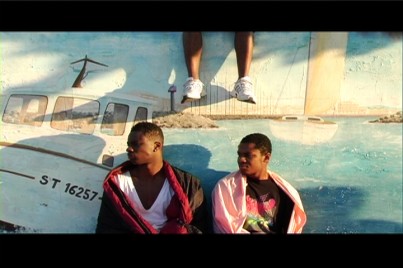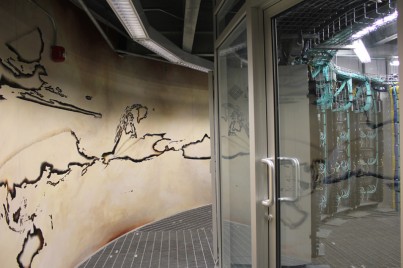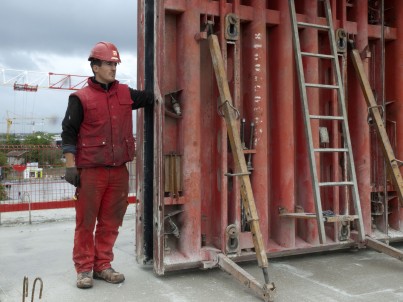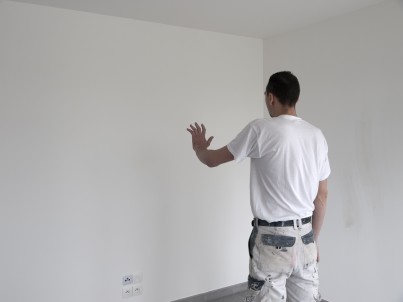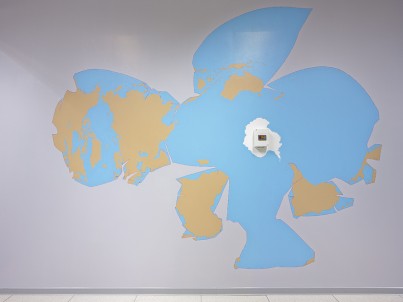Connection and disconnection
Interaction between creation AND mediation in light of contemporary art
The BBB centre d’art is set up in a former industrial electrical coil factory in Toulouse. Its team has been supporting contemporary artists in the field of plastic and visual arts since 1993. Production, works distribution and the conditions of their reception by art professionals and enthusiasts are the everyday life, ambition and long-term work of our trade. Creation AND mediation? This is the free invitation and question raised by Christian Ruby.
read Many discussions about contemporary culture still oppose creation and mediation. It is not uncommon to hear each of these notions defined in a tight-knit context. This way of fixating words, of isolating them, has a detrimental effect upon thinking. Above all it fails to acknowledge any links currently conceivable between existing cultural activities.
Our research into a European cultural history of spectators has strongly indicated that we cannot talk about classic, modern or contemporary exhibition works (as opposed to religious works), without referring in equal measure to spectators and artists. Also the spectator is the subject of an art, and by continuously being renewed, is likely to make a work of art of the spectator himself. These dynamics correlating works of art and spectators provide thinking material for this theme: creation and mediation, and above all outline the potential changes.
In a word, offering to determine the relationships between creation and mediation, means first of all understanding that words, like the people and the activities designated by them, cannot exist in full measure as separate worlds, under pain of death. It is necessary to stress the connections – and/or – and, as a consequence, the possible exchanges between them or the shift in their relationships. We must also learn to wield the function of ‘and,’ in such a way that it does not indicate overwhelming totality, but is instead in line with plurality banking on a continuation. This conjunction must involve friction, allowing new energy producing surfaces to prevail on both sides of the relationships between creator and mediator, in mediation intrinsic to creation (act and result), in creation intrinsic to mediation, lastly, in the relationship between creation and mediation.
A Mechanical Separation
Those who know the field of art know that it not only encompasses creators and creations, but at the very least spectators and mediators too: dealers; cultural intermediaries; institutional staff of the French Republic, …
If you are familiar with this field, you will also know that, since the expansion of cultural mediation (1980), relationships between creators and mediators have been strained, like between Jean de la Fontaine’s monkey and cat (in the eponymous fable). More often than not they ignore each other or pitch themselves against each other, sometimes believing that they have been duped. More often than not, those at the top of their field feel indebted to those prominent in mediation empowered to do anything for the artist’s success.
If this is the case, it is a fact, not a right, and a sad state of affairs. In many cases, it effectively still functions far too much like a kind of separation of duties. For mediators, public relations would take precedence; for creators tradition would dictate the work of art. Mediation would then creep into creation, but limited to considerations that are not essentially theirs, in line with the public and enjoyment in the pride in succeeding.
The First Change
It is advisable to extricate yourself from this automatic intention to separate. Contemporary art is conducive to this. It has a different approach to artistic ‘creation.’ It calls upon notions of ‘producing situations,’ research, developing experiments, contemporary archaeology, the activation of energy and provocation. It is likely that the notion of ‘creation’ no longer has any unilateral meaning.
We know that this notion has Biblical origins, even if modernists have reworked it. It is even said that: ‘In modernity, liturgy has provided the model for artistic activity, through a process that has reached full self-awareness for Mallarmé, but that has perhaps found its zenith in contemporary performances.’ Written by the philosopher Giorgio Agamben (Opus Dei : archéologie de l’office, (Opus Dei: An Archaeology of Duty) Paris, Seuil, 2012).
In any event, the secularization and continual transformation of the notion of creation offers new opportunities: a vision of creation as mediation, and no longer as an authoritarian act. In addition, contemporary ‘creation’ is engaged in a new correlation: this time, with the spectator. The image of creation in the spectator has become a moment in the ‘creation,’ like the creation of the ‘spectator.’ The latter becomes the mediation that gives life to creation. It can also be confirmed that the highlighted presence of the spectator changes the creation (the act and the result) into mediation.
The work is thus not only a mediator, but through the creation, on the one hand, by the artist (it does not exist prior to the process), on the other by the spectator, it should not be forgotten that he is on a trajectory and a permanent evolution, or a practice that does not involve waiting, passive, the revelation of a truth conveyed by the work.
A Second Change
If the cultural and artistic mediation concerned here is consistent with a clear social function, as well as with a new profession in contemporary society (even if at times it struggles to assert itself as such), convergence as well as institutional practices and links come into play within this function, as well as the definition of a necessary or possible, newly shared aim (artistic, political and aesthetical). In our society, external mediation (in general) more or less exists, but now mediators, staff whose function it is to establish or implement relationships within cultural programmes take precedence.
This role certainly warrants creation and relationships that requires being taken seriously. We cannot bypass mediators and their approach to culture, their concept of culture and the arts, and their concept of their role. For it is there that the preconceived notions of culture, of the public and of mediation activities, impact on the discourses and the practices focusing on art or cultural works, on the institutions to deploy and on exhibitions to present or interpret.
The understanding or misunderstanding of the discourse or attitudes by the mediators according to social and cultural relationships also depends on the concept of culture, the public and its activities, through mediators, among enthusiasts or the public. The notion about ‘the culture of others’ derives from this data, which of course, when one’s own concept of culture is normative, is always ‘secondary’ or ‘uneducated.’ The best way, in many cases, is to enjoy the opposite of a ‘dominant’ position in the field. Or to understand from mediation it is important to create a new self-concept or relationship with others.
Each other in turn
We can say that the current world of art benefits from a strange but central dynamic: perpetual movement, within which art, in all its forms (from creation to mediation) will in turn be creation and mediation. This requires considering it like in a work by the artist Peter Downsbrough, haunted by Gilles Deleuze’s philosophy. Coordination is possible around creation and mediation without aggregation, or a normative reference system, work on space and divergence that would lead not to entities, but seamarks continually forming archipelagos.
This other way of thinking consists of understanding that it would be possible to love creation and to practice mediation, to be as ready to work for one as to be prepared to develop the other, and reciprocally.
Another point to add is that their constantly changing relationship should remain critical and tolerate criticism, rather like Michel Foucault sketches out lineaments, with regard to counteracting ‘the meta-stability of institutional arrangements by relying specifically on their fundamental characteristics; to articulate different practices in a manner, not only to preserve the powers of challenges that are expressed forcefully and efficiently on a local level, but above all so as to intensify them whilst establishing from a pinpointed source of resistance a certain resonance with other struggles’ (in Michel Foucault, un parcours philosophique, Hubert Dreyfus and Paul Rabinow, Paris, Gallimard, 1984, p. 287sq). Michel Foucault: Beyond Structuralism and Hermeneutics)
* * *
The terms coupled together for our reflection, creation and mediation, are effectively subject to all sorts of movements that threaten and blur the fixed and unilateral intentions. Good! We can say that, for today, it is worth continuing to question the possible community of artists known in the past as ‘creators’ and mediators, in the light of contemporary art. Which also amounts to questioning the notion that is the most absent from contemporary discussions and talks: the spectator, even transformed alternately into observers, spectators, activators, pleasure-seekers and perceivers, …
Click on the image to launch the slideshow.
Further reading:
Christian Ruby, Doctor of Philosophy, teacher (Paris). Recent publications: L’archipel des spectateurs (Besançon, Editions Nessy, 2012); La figure du spectateur (Paris, Armand Colin, 2012).
BBB – centre d’art
Special
Issues
EDITO
RESTRUNG NECKLACE
The invitation to rearrange the contents of this web-based collection, reminds me of the passing down of a great Naga necklace. As if each slideshow, web-performance, video, text, or audio work, were loosened from a cotton thread, and laid out on a taut cloth, like carved white conch shells, brass bells, red carnelian, bone, and blue-green glass beads, waiting to be newly strung. As I read and listened through the contents, I began to dream of jewelry setters. And so here I tell, if you wish, a decentralizing story; not decentralized, but one whose claim has the capacity to make the centre, come to seem estranged.
After crossing an arc, at the eastern edge of India, is a hill region bordering Bangladesh, China, Southern Tibet, and Myanmar. Among the states of this area, is exquisite and troubled Nagaland, with its innumerable cultures, united under the word ‘Naga’ and yet with communities, each with differing and exceedingly democratic models of government, and different material culture. Its worldviews that have the potential to open new ways of thinking about art are preserved in fragments of remaining material culture after the onslaught of proselytism and modernization. Among them is the philosophical linking of ornament with society and individual ethics. In ancient times, and still practiced by the conceptual works of the artist Veswuzo Phesao, is the right to decorate one’s bodies, clothing, or one’s home, based on a system of being able to calibrate individual merit as value: which was always somehow, value earned within a community, through codified rituals of generosity. Status came from having always individually earned it. A warrior, or one who fed his surplus crops to the village, these were the terms under which one was given permission to decorate one’s home. After passing on, one’s children could not inherit the ornamentation; they again would have to individually earn the right from society.
Over 2007 and 2008, I spent time in this region, writing about its contemporary art, and have been going back ever since. Hekali Zhimomi, the then director of a government-run art centre, the North East Zone Cultural Centre, told me of her own research into jewelry and value. In Ao Naga culture, she explained that when a work of jewelry is passed down, or purchased, before buying it, the new wearer must hear all the stories and merits of its first maker and past owners. It is through their personality and deeds that the work of jewelry could accumulate value. The work of jewelry has ethical provenance. And the character of its past wearers, is a strong determiner of its value, translatable into a shop price, but in reality a contemporary oral tradition of storytelling in continuance – where a graduate degree may be a new determiner of social achievement. For the Naga communities, jewelry – like all aesthetic and ritual – has been over time coded, eroded and re-coded.
It is a lens and a trope through which to perhaps read the particular form of value, in the efforts of such a website – to hold together the fifty centres d’art contemporain across France in one light website: whose entries are arranged by center, by author, or by the materiality of response. The series, and resetting of the series, gives the impression that there are also infinite subjective arrangements possible. The invitation to four editors from far-flung parts of the world, to restructure the contents of the website, with a new editorial over the course of four seasons, implies a seriality ricocheting within the content, like a musician within the set notes of a raag.
But our carnelians and glass beads here, as the first stringers would tell us, are the many turns of the die, an encounter with an idea and its potential. In this sense, what has accrued, are the ideas. The rituals of handing down jewelry, something always a little intimate and formal together – have the weight of history; at least of those small histories of people in the air. As if all those souls were summoned to the jewelry box. Conch shells, carnelian and glass beads remind me of ways of approaching biography and the lives of artists, of pedagogy and the ways we have of passing through and accruing knowledge, and the many ways of approaching value. But in focusing on biography, there is a ringing sense of missing colours and beads. I cannot speak out here for all that is absent, yet perhaps we could leave space in the necklace for all those ideas that come from biographies of differance, still to be strung in the centres d’art. With this thought, I pass this necklace on to my colleague, and friend, across the Nagaland border…
* * *
1. Inheriting ideas
Presented by the Centre d’art contemporain de Brétigny, Matthieu Saladin writes a text to accompany an exceptional sound score made in 1968, ‘LIKE A CLOUD HANGING IN THE SKY?’ by the group AMM. The group in turn had made this work in response to a prose work, ‘Sextet: The Tiger’s Mind’, by one of its members, Cornelius Cardew. What is key to my own arrangement, is the way Saladin’s text approaches artistic inheritance. In Saladin’s own writerly and artistic engagement with a double inheritance of the two works, he emphasises how ‘Like a Cloud’ was not a performance of ‘The Tiger’s Mind’, but an engagement with it, through new experimentation.
Emmanuelle Pagano’s ‘NIGHT-LIGHT’, at Espace de l’art concret is a writing experiment. It is a novelist’s selection of works from the Albers-Honegger Collection that performs a similar function in re-stringing works, by new criteria. These objects handed down to us – works of glass, a globe of light – are given emotional life, through the biographic form of storytelling, by which he links the defiance of gravity by an astronaut, with that of the glass blower.
“I am a glass blower, like my father, like my grandfather, my great grandfather. I love working with glass, it becomes full of life under heat. From this magic material it’s possible to make so many things, endlessly fashion it, give it any shape. One only has to stop it from yielding to gravity, Earth’s crushing call. In our family we have been defying gravity for several generations…When younger I wanted to be completely free from it, from gravity, I wanted to become an astronaut.”
2. Glass beads and the oral tradition
‘Glass does not forget anything.’
It is Thomas Golsenne who writes in his text about the relationship between the artist and the technician, called ‘THE HEART AND SOUL OF GLASSWORKING’ written for CIRVA – Centre international de recherche sur le verre et les arts plastiques:
“However, in music, the difference is that, if the musician plays a wrong note, he can always make up for it with the following note, whereas, in glass-blowing, it is impossible to make up for mistakes: everything has to be perfect from the moment when the glass is gathered in a furnace to the time when it is placed in another, less hot furnace, to allow it to cool. Glass does not forget anything.”
Nicolas Floc’h writes with beauty in ‘DEEP IN THE HEART OF THE SUBJECT’ for Centre d’art Le Pavé dans la Mare. In his writing, the glass becomes the material of philosophy. In a passage he compares glass with wine-making, referring to the passing down of technique, of knowledge, and ideas. “The secret of the process probably owes… also to a human chain of know-how and knowledge involved from grape-harvesting to the wine-making process.”
The oral tradition is in continuance, within contemporary art. In this case he also talks about the technicians being the ones to carry down the knowledge they have of glass, to the next artist entering the studio. To the triangles made between artist, audience and curator or institution, is the welcome addition by Golsenne of the role of the technician:
The artist “discovers the enormous furnaces, which give off air so hot that it makes the lamps swing, hanging from the ceiling several metres above. He discovers the material and its different states: small white beads (pellets) at the beginning, then a soft red-hot mass when it is gathered in the furnace and handled with the blow tube, and finally a solid, transparent volume when it has cooled down. He especially discovers these characters, these masters of the art of glassmaking, who have given everything for their passion, who hold all the secrets of the technique, and who are nevertheless there, simple and modest, listening to his words, wishing to please him, ready to go with him on a journey to the unknown in this future project.”
3. Questioning the biographic voice
Aymeric Ebrard, uses an alacrity of visual and aural description, in an autobiographical narrative, to capture being split: in this case, between two different residencies, in Lithuania and Morocco, intercut with each other in close succession. The text is a double view, titled with the cinematic ‘The Kuletchov effect’, suggesting something else arises from the combined meaning of two vivid and dissimilar images. What it captures, is for me, a form of writing in whose own poetry is wrapped a deeply clear, political voice. Take this sentence on Saïdia, at the Moroccan-Algerian border: “On either side, the run-down buildings would prance their social housing pealing volumes next to the camp pavilions owned by the Minister of Youth Affairs and Sports.” Ebrard writes within ‘MODELS OF PRODUCTION’, at Centre d’art bastille. I am reminded, in my own insistence in listening for the first person, poetic voices, of Helene Cixous’ writing, and many others – that taut, crystal, political gleaning that accompanies each double-entendre.
‘I AM ALL WORDS’ is an extraordinary work by Adva Zakai, using the medium of a website, to convey her own métier, choreography. The curator of Le Quartier, Centre d’art contemporain de Quimper has written, “I’m now inviting you to pursue the project of ‘becoming an art centre’, but within the virtual space of Internet.” In an imaginatively intimate form of address, Zakai uses the first person, or the biographic approach, to tell the audience, the immediate precedents of where they are and what they are viewing, “opening is a solo where you stand on a table in a corner of the exhibition space. Your hands touch the walls, and very slowly you raise one leg. While you’re trying to keep a balance, you tell a story which could be your biography, the history of the space or the story of the director.”
In a series of letters, Guillaume Pinard and David Evrard discuss themselves, their own personalities, in ‘NOBODY CAN ESCAPE ART’ for Maison des Arts Georges Pompidou. From their lively writing, we hear a self-reflexive discussion of value and consumerism, gift-exchange, and collecting.
The director of La Galerie – Centre d’art contemporain de Noisy-le-Sec, Emilie Renard, corresponds with the art critic Sinziana Ravini in ‘DEAR SINZIANA V. DEAR EMILIE’.
These exchanges, seem to speak directly to the problematics posed by the necklace. Their exchanges question the biographic approach, the biography of the artist as a value within the reading of the work, and on gift-giving exchanges and translations between value systems. In candid writing, they analyse and reflect on the use of the first person as a fictional device, or as an autobiographical style, which they comment on as different to the “theoreticians from October”; a style that runs at odds perhaps with a scientific analysis of artworks. “Now I think the big issue of our time is the complete opposite of all that, the need to reclaim art discourse for the emotional domain, that mysterious theatre of the unconscious that’s there whether we like it or not. But to do that you have to be ready to expose yourself, lose your way, make mistakes and most of all, exaggerate.”
From this perspective, is also Aurélien Mole’s use of a futuristic, exaggerated, biographical voice in ‘HIATUS’ written for Parc Saint Léger.
“Based on the documents and oral sources that I collect from the area surrounding the Parc Saint Léger, I am virtually able to reconstitute what the art centre’s whole programme had been, both inside and outside of its walls. Other historians will use this information to extrapolate a sense of what cultural life was like in Europe between 2000 and 2075, and thus attempt to rewrite history from its margins.”
Jean-Pierre Cometti’s ‘BUT THE MAIN PROBLEM LIES ELSEWHERE…’ is a beautifully written work for Centre national d’art contemporain de la Villa Arson. Cometti writes revealingly, of how art needs to be located within context – what he sums up productively as “when is art?”
“The difference with what we usually call “experimentation”, for example in science, is that this kind of approach is not directly geared towards producing knowledge; but this does not in any way signify that they don’t pertain to knowledge. One can easily be convinced of this. In science and in philosophy, we have what are called “thought experiments”. A thought experiment means introducing an unrealized (counterfactual) possibility in the reasoning process, and estimating its consequences were it to be realized. This type of approach makes it possible to open up the concept of knowledge and to enrich it by allowing for wider and more inclusive forms of understanding. This is the privilege of fiction, and also of art.”
4. Valuing the political voice
“Even if I think that art is all about context (does not exist outside a certain place, a certain time, a certain onlooker) and all about audience (it is in relation to the audience the artist determines what has to be done), I think art is also all about the intention of an individual, the artist” writes Dora Garcia in “I UNDERSTAND MY ACTIVITY AS A RESEARCH” for 3 bis F – centre d’art contemporain. She gives the example of “The Beggars Opera” 2007, which she defined as “theater play in real time and public space”- for Münster Sculpture Projects.
“In this work, I created a tool to dismantle the conventions of art in public space…The work consisted of a character, Charles Filch, a secondary character from the Bertolt Brecht play and novel The Three Penny Opera, which “came alive” in Münster and became a citizen of the streets of Münster during the three months of the exhibition. It had all the qualities one should ask of an artwork in public space (existed in public space, changed the perception of it), and at the same time it was obviously a person- personnage and to reduce it to the condition of a number on an outdoor sculpture map was absurd.”
The most art historical of all the texts, is possibly, that of Gilles Drouault, who recalls brilliantly in the video, ‘THE WITNESSES’ at Centre d’art contemporain d’Ivry – le Crédac, an exhibition of particular value to him, and he explains generously why. To him, this exhibition on industrialisation in the last century; was pertinent to its location in an once billowing industrial town of Ivry. Intrigued at how film and industry developed at the same time; he conjectures, that what has been most compelling about the 20th century, has been the development of the industrial world and the worker; premising that what was siginificant to the 20th century in particular was the worker as an individual with rights, worker’s strikes, as capable of forming trade unions. One of the achievements of the Western European system has indeed been the welfare of workers.
5. Necklace of strategies
The political subject matter in Alexandre and Florentine Lamarche-Ovize in ‘LAMARCHE-OVIZE, A COLLABORATION PROJECT’ for Micro-Onde, centre d’art de l’Onde, show a work dealing with women’s prisons. Antoine Marchand in ‘LET’S MEET IN TROYES, AUBE’ at Centre d’art contemporain / Passages, discusses being invited to devise ways to dispose of nuclear waste, and the ability of an artist to respond, or give value, to such a residency. Fabien Faure in ‘THE TIME OF SITE’ at CAIRN, centre d’art, writes of mining and its relationship to land art. Yet, there is also political strategy latent in the writings, for example, of Olivier BossCentre rhénan d’art contemporain, has a moment, where so as not to be surveilled, by the number of webcameras one takes in the subway, is suddenly a face, painted like the dazzle-pattern used in submarines during the First World War. It gives a moment to delve underwater and dip into art history, as something actively working as strategies in a politicized world – if one thinks of cinema, then terrifyingly and increasingly used today. In another discussion of cinematic effect, ‘EMPOWERMENT’, at Jeu de Paume, Antoine Thirion a critic, responds to an artist Claudio Zulian, who has been using cinema as a political tool, using historical re-enactments, and repetition as a strategy. I end this arrangement, with a performance: Emma Dusong makes the web-performnace ‘DOOR’ for Centre régional d’art contemporain Languedoc-Roussillon.
Zasha Colah
February, Bombay
CONTENTS
1. Inherinting ideas
THE CAC BRÉTIGNY - CENTRE D’ART CONTEMPORAIN DE BRÉTIGNY
L’ESPACE DE L’ART CONCRET
2. Glass beads 'Glass does not forget anything.'
LE CIRVA - CENTRE INTERNATIONAL DE RECHERCHE SUR LE VERRE ET LES ARTS PLASTIQUES
THE CENTRE D’ART LE PAVÉ DANS LA MARE
3. Questioning the biographic voice
THE CENTRE D’ART BASTILLE
LE QUARTIER, CENTRE D’ART CONTEMPORAIN DE QUIMPER
LA MAISON DES ARTS GEORGES POMPIDOU
LA GALERIE - CENTRE D’ART CONTEMPORAIN DE NOISY-LE-SEC
LE PARC SAINT LÉGER
THE CENTRE NATIONAL D’ART CONTEMPORAIN DE LA VILLA ARSON
4. Valuing the political voice
THE 3 BIS F - CENTRE D’ART CONTEMPORAIN
THE CENTRE D’ART CONTEMPORAIN D’IVRY - LE CRÉDAC
ABOUT
Bolstered by its success and visibility, uncoupdedés.net is restarting and subjecting existing content to new voices. In 2014 and 2015, several personalities from outside France will be asked to become our editorial writers for one season. Their task will be to place the contents of the whole magazine in perspective, presenting them differently through the prism of their subjectivity and their own work contexts. Catalina Lozano (Colombia), Zasha Colah (India), Moe Satt (Myanmar) and Manuela Moscoso (Brazil): each guest editor will reformulate the actions of the centres d’art, various aspects of which they will have been able to perceive through the magazine. Each editor-in-chief will “roll off” a cross-cutting text, presenting an original re-examination of the resolutely fluid geography of the centres d’art. uncoupdedés.net repeats the challenge from the poet Mallarmé, resurrected in the cinematographic art of Jean-Marie Straub and Danièle Huillet (Every Revolution is a Roll of the Dice, 1977). The guest editors, coming from a variety of disciplines, will widen the circle of expression even more. Choral and fragmentary, uncoupdedés.net takes just as much after puzzles as it does after memories, and naturally calls for cut-outs of every kind…
•
ZASHA COLAH
(Bombay, India)
Zasha Colah co-founded ‘blackrice’ in 2008 in Nagaland, and the Clark House Initiative in Bombay in 2010, after studying art history at Oxford University and curatorial studies at the RCA, London. She was the curator of modern Indian art at the Jehangir Nicholson Art Foundation at the CSMVS museum (2008- 2011), and was head of Public Programs at the National Gallery of Modern Art (2004-2005) in Mumbai. In 2012 she co-edited ‘In Search of Vanished Blood’ a monograph on artist Nalini Malani for documenta 13, and she curated two exhibitions of Burmese art, ‘Yay-Zeq: Two Burmese Artists Meet Again’ at ISCP New York and ‘I C U JEST’ in Kochi.
